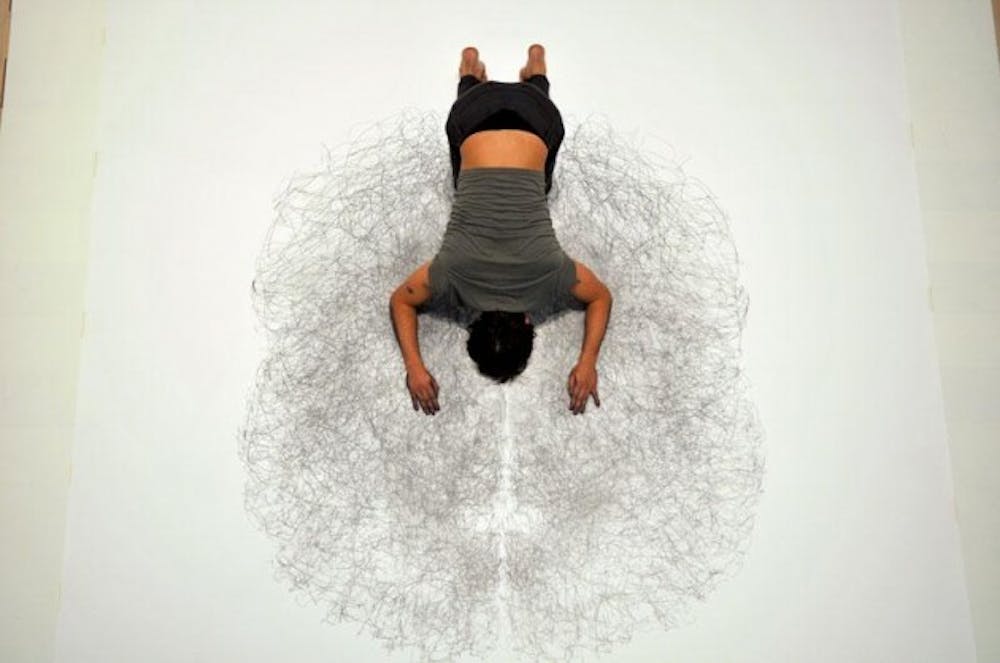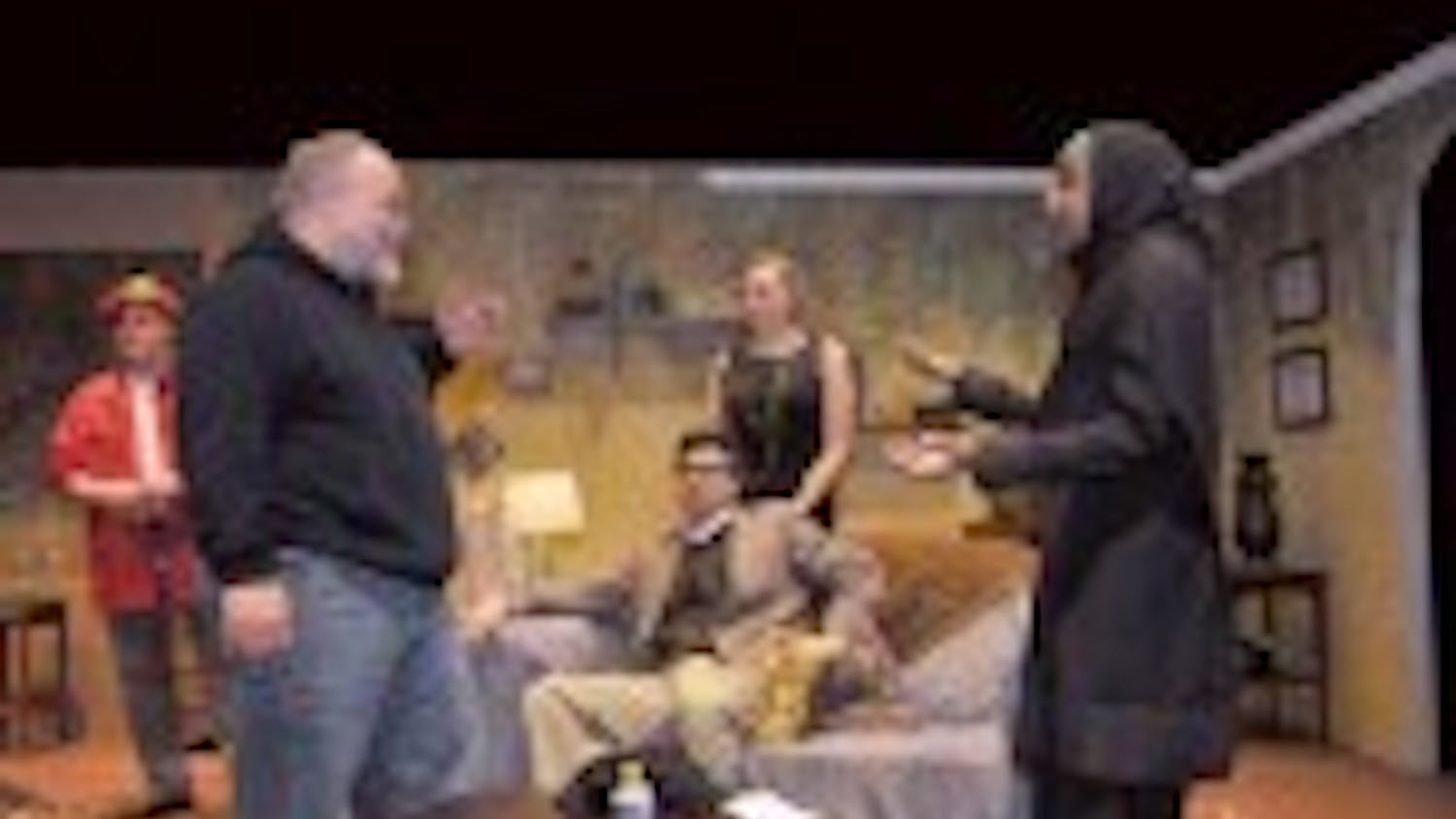It takes three hours for Tony Orrico to go from lying facedown to standing. Those three hours are every bit as painful for his audience as they are for him.
On Wednesday - from 4 p.m. to 7 p.m. in the Lightwell Gallery at UB's Center For the Arts - Orrico produced his "Prone to Stand" impression, number 12 from his Penwald Drawings series, in a live performance.
Also referred to as the "human spirograph," Orrico reinvented drawing as a form of art in Penwald Drawings, paying homage to Leonardo da Vinci's "Vitruvian Man" in a process that is both physically and mentally demanding.
Orrico's performance consisted of three phases - each lasting an hour - of bilateral drawing (sketching two images at the same time with both hands). Orrico began in a prone (facedown) position, moved into a downward-facing crouch and finished in a bounce between a squat and toe-touch stance that ends in an upright position.
Three hours. No stopping.
In the far reaches of the Lightwell Gallery, Orrico calmly arrived on time with no grand entrance. Before an eager audience and an oversized blank sheet of paper, Orrico stood like a martial artist waiting for a command before his routine commenced.
"Start," said Sandra Firmin, curator of UB's two art galleries.
He lay facedown as the clock started ticking. Orrico began to work his lines over the page with outstretched arms, using varying movements from the prone position. His arms never stopped to move for more than a second throughout the entire performance; the rest of his body kept completely still.
Orrico's grip on the pencil never lost strength though it changed often. At times, he resembled a kindergartener holding a crayon, and at others, his grip was limited to a few fingers, making the pencil virtually invisible to the audience.
The impression built, and it's remarkable how closely the fine details and density of the lines were mirrored on both sides of Orrico's body. His eyes remained mostly closed and he fired out a few quick, sporadic breaths as a focus mechanism.
The audience felt Orrico's discomfort, but he never broke a sweat or showed it in his execution. His body heat in the first position was so intense that at one point the paper ripped as it expanded.
"Change," Firmin said at the one-hour mark.
Orrico then crouched into a position similar to the rabbit yoga pose, legs and head on the floor with his posterior in the air. It became clear blood would rush to his head for the entire second hour. This made the crowd uneasy, as several audience members gathered themselves and exited the gallery while new ones were just arriving.
"I thought it was intriguing," said Kelly Magee, a sophomore art major who left during the second hour. "I think it takes a lot of trust to not watch what you're doing as an artist and have the final product be a surprise."
The lines from the second position of the performance combined with lines from the first to form a more abstract image, and what originally looked like the top view of a brain scan became a Venn diagram of pulsing lines.
"Change," Firmin said, initiating the third and final position of Orrico's performance.
Orrico slowly entered a position much like a catcher would take in baseball with his feet kept together. As he paused for a moment, his face was visible to the audience for the first time since he began. Signs of strain showed on his graphite-dusted skin for the final hour, but his piercing blue eyes maintained tremendous focus.
This point in the performance proved to be a test of endurance - not only for Orrico, but for the audience members who stayed with him from the start.
"You become concerned for him, but I was sort of right there with him and I connected with him," Firmin said. "I felt like there was a psychological tether connecting us that I didn't want to leave."
Orrico bounced and breathed sharply as he danced his lines on both sides of his body. The spot where his head rested in the second position had a stain of sweat and what seemed to be blood. Audience members waited for the final word, as they grew impatient to see the final result of Orrico's piece.
"Stop," Firmin said.
After three grueling hours, Orrico slowly rose to a standing position where he paused and then nodded to the crowd. Applause roared from the floor and balcony above as Orrico stepped away from his masterpiece, leaving two pristine footprints at the base of his impression.
The final image of three intertwined circles varied in density and line thickness, and a negative space ran through the center like a path for Orrico's feet to follow.
Afterward, some members of the audience rushed to speak with an elated Orrico as others gathered for a closer view of the impression.
"When you spend enough time with these kinds of body practices, you start to learn them as a new behavior the way that we have behaviors without practice like eating and walking," Orrico said. "They become part of me over time, but I don't practice the drawings. The real experience is the interaction with the audience. I enter with a little bit of fear and anxiety, and I'm interested in how I can ground that and get into the drawing and escape inside of it."
Orrico's art will be featured at the UB Art Gallery in the "Falling through Space Drawn by the Line" exhibition through Dec. 8.
Email: arts@ubspectrum.com





